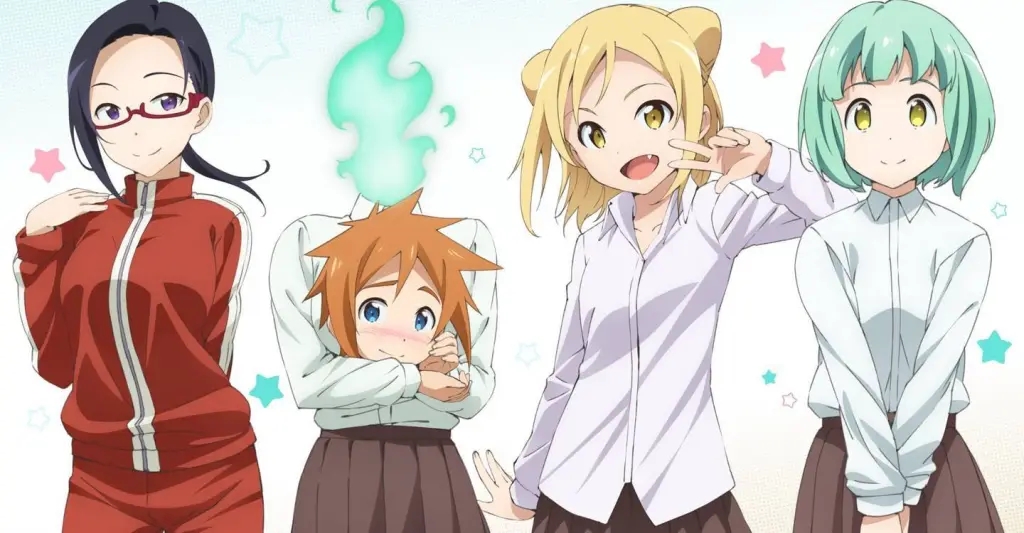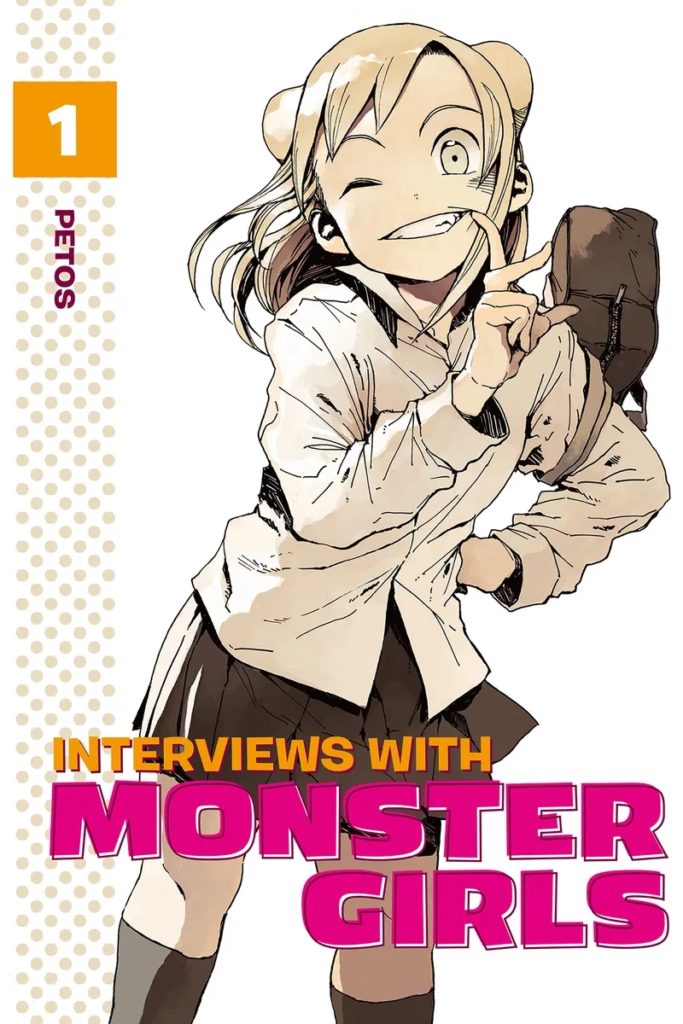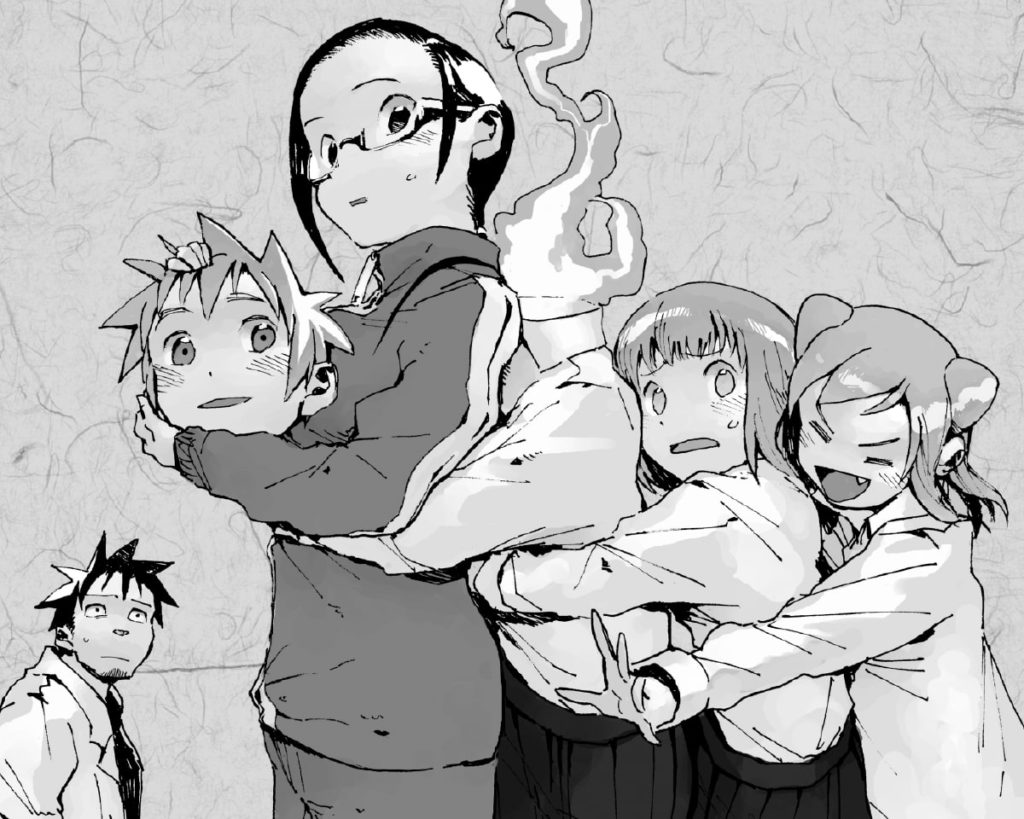Interviews with Monster Girls
November 2, 2021 · 0 comments
By Jeannette Ng.

Interviews with Monster Girls by PETOS starts off more or less as its title promises. Tetsuo Takahashi is a biology teacher who has long been fascinated by the existence of demihumans. Some combination of narrative contrivance and fate has resulted in him sharing a school with four of them — Hikari Takanashi the vampire, Kyoko Machi the dullahorn, Yuki Kusakabe the snow woman, and Saki Sato the succubus — and he is keen to make use of this opportunity to literally interview them.
It might just be the utter cultural saturation of vampires in every possible medium (Sarah Anderson’s Fangs remains a stand out for anyone who’s looking for more slice of life vampire stories), but Hikari’s initial debunking of vampire tropes feels like a faintly tedious retread. The energetic and outgoing Hikari herself does bring an amusing perspective when we dive deeper into her home life and her habits. She insisted, for example, on having her own fridge so that her government-issued blood packs could be kept separate from her family’s groceries, implying that she might be ashamed of her vampirism — but her twin sister, Himari, sees through this and calls her out for just wanting a private fridge to hide desserts in.
Quite the opposite of the ubiquitous vampire is the Kyoko Machi, a demi of Irish folklore whose head and body are separate. Her detached head is a source of considerable inconvenience and unique visual gags but also endless fascination as the characters try to answer questions as to how her head and body are still somehow connected — she eats and drinks with her mouth, after all, and it all somehow ends up in her stomach. It is through her that we get some of the most interesting world building, metaphysics and physics speculation.

Saki Sato is a succubus and a maths teacher. Whilst she doesn’t exactly feel like she has her life all sorted out, she is not finding herself the way they are. She goes to great lengths to not accidentally arouse those around her as not only does physical contact inspire immense lust, she also projects sexual dreams as an area effect when she is asleep. She has given up on the idea of love as she fears anyone interested in her would only be lusting after her succubus self. She first develops a crush on Takahashi because he seems immune to her immense sexiness, though it transpires he just has a reasonably good poker face.
Yuki Kusakabe fears being defined by the tragic fate of all snow women in fairy tales, but as Takahashi helps her understand her unique condition and the limits of her powers, she befriends the other girls and allows herself again human contact.

It is a couple of volumes before Interviews with Monster Girls hits its stride. Its early chapters adhere rather more closely to the titular conceit and feature interviews (really more counselling sessions) as their narrative focal point. It is also in those chapters that the narrative more seriously baits the reader with the possibility of teacher/student romances, with Machi’s blossoming crush and Hikari’s long conversations with him about how sexual blood drinking is or isn’t to her. For a good few chapters, the dynamic between Takahashi and the girls seems to be building up to another Negima! Magister Negi Magi where inappropriate crushes on teacher are seemingly half the plot.
But as the volumes unfold, the primary focus shifts away from Takahashi and whilst not exactly a bait-and-switch, we move away from this being a story about how very uniquely understanding, sensitive and heroic sensei is. It’s no longer a softboi saviour fantasy. Instead, it becomes much more a story about the demis bonding with one another, forming a support network of their own. It is, for example, Hikari who notices Machi struggling with the regulation satchel and asks Takahashi if he could get the girl permission to use a backpack instead. In volume four, the narrative deals with Takahashi’s closeness with their girls more directly with the school’s principal taking notice. The other students also realise that maybe the demis always ask Takahashi for help because no one else seems to take any interest and that they too could make an effort.

From the way elves are treated in Bioware’s Dragon Age series to the discrimination against animal people (“faunus”) in the anime-esque RWBY, racism has been the dominant lens through which fantasy races have been written in English language media. It is also one of the two politically relevant metaphors that fuel the unending X-Men franchise. Quality of metaphor and actual resonance differ from work to work, of course, but it is always striking to me see art that manages to deviate from these well-worn blueprints. Instead of racism, the primary real-world touchstone for Interviews with Monster Girls seems to be ableism.
The world isn’t built for demis. For all that their respective conditions are a series of rather mundane inconveniences, the world regards them as exotic and strange. The slice of life drama of the series gives the characters plenty of space of muse on the folkloric stereotypes that define them between the shopping trips, summer fun and convoluted misunderstandings. There’s a lot of fun to be had in the more whimsical chapters, like that of Hikari ranking all the arms of her friends’ for their chewability (she doesn’t drink their blood but the itch to “chew” is great and everyone indulges her).
Aside from modernity apparently bringing about a general mellowing of attitudes against demihumans, the primary background political milestone for them isn’t some a civil rights bill but a social safety net of housing and benefits. Whilst hardly explored in any great detail, the implication is clear and fits in neatly into the story’s larger themes of acknowledging and addressing difference. The point shouldn’t be to treat everyone “the same” so much as making sure everyone has what they need to achieve the same goal — even if what they need is different.

Machi plans much of her life around the fact that her head is detached and the ways in which that makes her vulnerable. She is picked up from school by car when it rains. And though her body does swim and play water polo, her head stays very much dry by the side of the pool. Dullahorns are rare even in a world with demihumans and all her coping strategies need to be unique, with her and her parents just making it up as they go (a panel with toddler Machi’s body in one pushchair and her head in another is particularly delightful). The other demihumans have their struggles too, with Hikari and Yuki both being vulnerable to the heat and direct sunlight. Hikari especially gears up for the season with UV-filtering tights and sunscreen, trying to balance her cute summer outfits with sun protection.
Saki Sato’s succubus problems are rather different from the other girls, given how she exudes a passive mind control on everyone around her. She works hard to minimise its effects, always wearing an “unsexy” tracksuit and taking great pains to avoid all crowded spaces. She is constantly trying to make herself smaller, be less conspicuous, become less of an inconvenience to others, and her arc seems to be one of realising that she may have more control than she thought over her seduction powers and that she is allowed to take up space and exist in public.
None of this is to say it’s story is a rigidly direct one-to-one allegory or that is has no resonance or applicability outside of being a metaphor. Far from it. Conversations between the human students trying to ignore how different the demis are very reminiscent of current debates around “colour blindness” as an ideal, that to not see difference means you are also ignoring the ways in which people who are different may be struggling.
There is a lot to recommend Interviews with Monster Girls. In this write-up, I’ve tried to sketch out these big themes and ideas, but it is also just this delightfully breezy slice of life drama with very solid worldbuilding. The art is expressive and sharp, contorting and scrunching appropriately into exaggerated chibis and doodles as the humour requires. I am very much looking forward to the next volume of this.
Jeannette Ng is the author of Under the Pendulum Sun. Interviews with Monster Girls can be sampled at Azuki, the manga café.
Leave a Reply